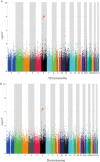Genome-wide association study confirming association of HLA-DP with protection against chronic hepatitis B and viral clearance in Japanese and Korean
- PMID: 22737229
- PMCID: PMC3380898
- DOI: 10.1371/journal.pone.0039175
Genome-wide association study confirming association of HLA-DP with protection against chronic hepatitis B and viral clearance in Japanese and Korean
Abstract
Hepatitis B virus (HBV) infection can lead to serious liver diseases, including liver cirrhosis (LC) and hepatocellular carcinoma (HCC); however, about 85-90% of infected individuals become inactive carriers with sustained biochemical remission and very low risk of LC or HCC. To identify host genetic factors contributing to HBV clearance, we conducted genome-wide association studies (GWAS) and replication analysis using samples from HBV carriers and spontaneously HBV-resolved Japanese and Korean individuals. Association analysis in the Japanese and Korean data identified the HLA-DPA1 and HLA-DPB1 genes with P(meta) = 1.89×10⁻¹² for rs3077 and P(meta) = 9.69×10⁻¹⁰ for rs9277542. We also found that the HLA-DPA1 and HLA-DPB1 genes were significantly associated with protective effects against chronic hepatitis B (CHB) in Japanese, Korean and other Asian populations, including Chinese and Thai individuals (P(meta) = 4.40×10⁻¹⁹ for rs3077 and P(meta) = 1.28×10⁻¹⁵ for rs9277542). These results suggest that the associations between the HLA-DP locus and the protective effects against persistent HBV infection and with clearance of HBV were replicated widely in East Asian populations; however, there are no reports of GWAS in Caucasian or African populations. Based on the GWAS in this study, there were no significant SNPs associated with HCC development. To clarify the pathogenesis of CHB and the mechanisms of HBV clearance, further studies are necessary, including functional analyses of the HLA-DP molecule.
Conflict of interest statement
Figures

References
-
- Arauz-Ruiz P, Norder H, Robertson BH, Magnius LO. Genotype H: a new Amerindian genotype of hepatitis B virus revealed in Central America. J Gen Virol. 2002;83:2059–2073. - PubMed
-
- Hoofnagle JH, Doo E, Liang TJ, Fleischer R, Lok ASF. Management of hepatitis B: Summary of a clinical research workshop. Hepatology. 2007;45:1056–1075. - PubMed
-
- Yokosuka O, Kurosaki M, Imazeki F, Arase Y, Tanaka Y, et al. Management of hepatitis B: Consensus of the Japan society of Hepatology 2009. Hepatol Res. 2011;41:1–21. - PubMed
-
- Tada H, Uga N, Fuse Y, Shimizu M, Nemoto Y, et al. Prevention of perinatal transmission of hepatitis B virus carrier state. Acta Paediatr Jpn. 1992;34:656–659. - PubMed
-
- Stevens CE, Toy PT, Taylor PE, Lee T, Yip HY. Prospects for control of hepatitis B virus infection: implications of childhood vaccination and long-term protection. Pediatrics. 1992;90:170–173. - PubMed
Publication types
MeSH terms
Substances
LinkOut - more resources
Full Text Sources
Other Literature Sources
Research Materials

